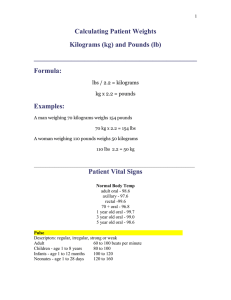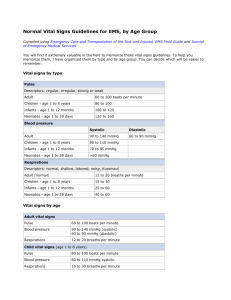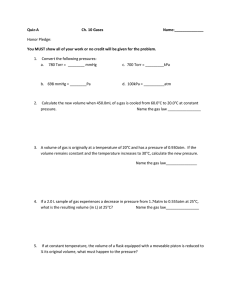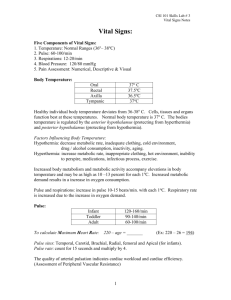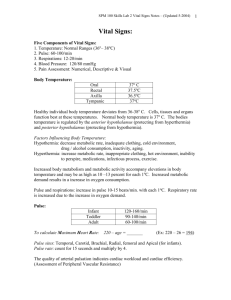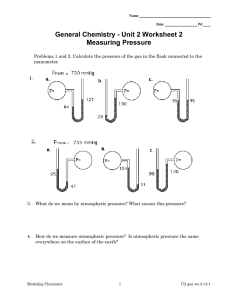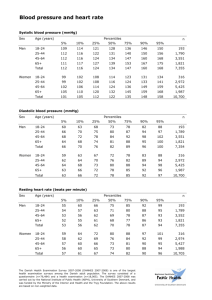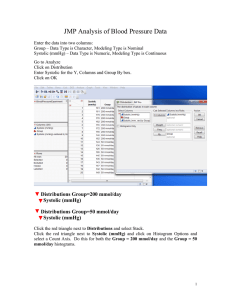Calculating Patient Weights Kilograms (kg) and Pounds (lb) ________________________________________________
advertisement
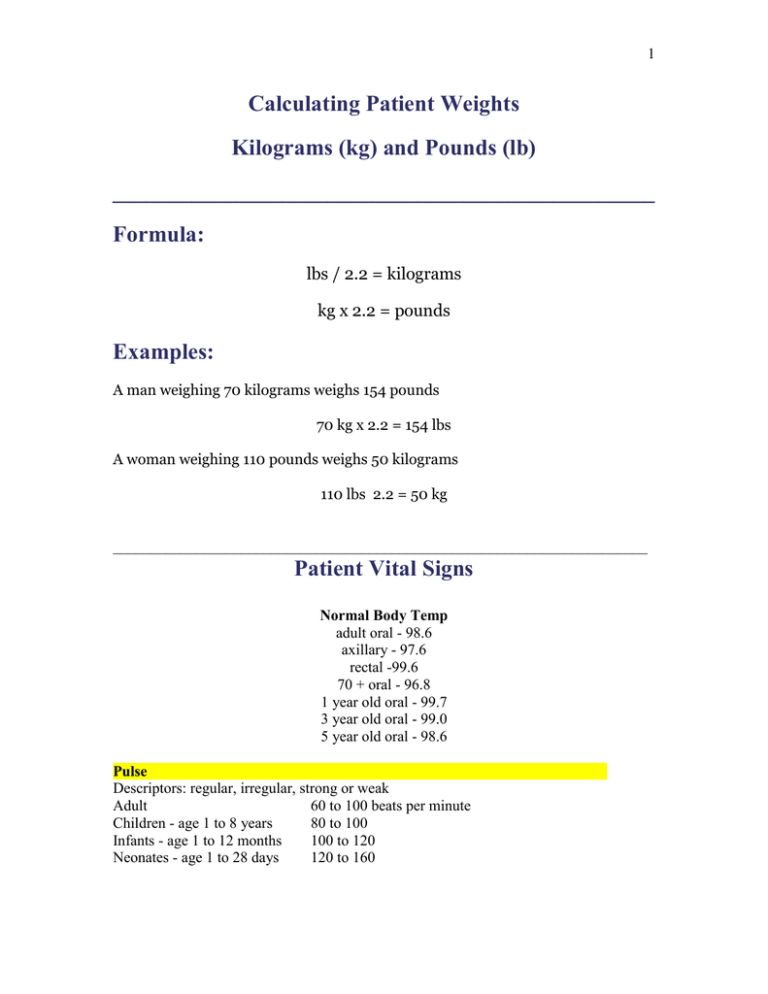
1 Calculating Patient Weights Kilograms (kg) and Pounds (lb) ________________________________________________ Formula: lbs / 2.2 = kilograms kg x 2.2 = pounds Examples: A man weighing 70 kilograms weighs 154 pounds 70 kg x 2.2 = 154 lbs A woman weighing 110 pounds weighs 50 kilograms 110 lbs 2.2 = 50 kg _______________________________________________________________________ Patient Vital Signs Normal Body Temp adult oral - 98.6 axillary - 97.6 rectal -99.6 70 + oral - 96.8 1 year old oral - 99.7 3 year old oral - 99.0 5 year old oral - 98.6 Pulse Descriptors: regular, irregular, strong or weak Adult 60 to 100 beats per minute Children - age 1 to 8 years 80 to 100 Infants - age 1 to 12 months 100 to 120 Neonates - age 1 to 28 days 120 to 160 2 Blood pressure Adult Children - age 1 to 8 years Infants - age 1 to 12 months Neonates - age 1 to 28 days Systolic 90 to 140 mmHg 80 to 110 mmHg 70 to 95 mmHg >60 mmHg Diastolic 60 to 90 mmHg Respirations Descriptors: normal, shallow, labored, noisy, Kussmaul Adult (normal) 12 to 20 breaths per minute Children - age 1 to 8 years 15 to 30 Infants - age 1 to 12 months 25 to 50 Neonates - age 1 to 28 days 40 to 60 Vital signs by age Adult vital signs Pulse Blood pressure Respirations 60 to 100 beats per minute 90 to 140 mmHg (systolic) 60 to 90 mmHg (diastolic) 12 to 20 breaths per minute Child vital signs (age 1 to 8 years) Pulse 80 to 100 beats per minute Blood pressure 80 to 110 mmHg systolic Respirations 15 to 30 breaths per minute Infant vital signs Pulse Blood pressure Respirations 100 to 140 beats per minute 70 to 95 mmHg systolic 25 to 50 breaths per minute Neonatal vital signs (full-term, <28 days) Pulse 120 to 160 beats per minute Blood pressure >60 mmHg systolic Respirations 40 to 60 breaths per minute Adventitious (Abnormal) Lung sounds 3 Crackles or rales Wheezing Stridor Rhonchi crackling or rattling sounds high-pitched whistling expirations harsh, high-pitched inspirations coarse, gravelly sounds Pulse oximetry Range Normal Mild hypoxia Moderate hypoxia Severe hypoxia Value 95 to 100% 91 to 94% 86 to 90% < 85% Treatment None Give oxygen Give 100% oxygen Give 100% oxygen w/ positive pressure Common Measurements Temperature Formula: 1 degree Celsius (ºC) = 5/9 x (ºF - 32) Formula: (9/5 x ºC) + 32 = 1 degree Fahrenheit (ºF) Example: 98.6ºF (normal adult body temperature) = 37ºC = normothermia < 95ºF = hypothermia (too low) 37.5 °C –38.3 °C (100 °F –101 °F) =hyperthermia (too high) Note: Hyperthermia differs from fever in the mechanism that causes the elevated body temperatures: a fever is caused by a change in the body's temperature set-point. For hyperthermia, the most common causes are: heat stroke and adverse reactions to drugs. Malignant Hyperthermia (MH) is a rare complication of some types of General Anesthesia. _____________________ Temperature Classification 4 Core Temperature Ranges Normal 36.5–37.5 °C (97.7–99.5 °F) Hypothermia <35.0 °C (95.0 °F) Fever >37.5–38.3 °C (99.5–100.9 °F) Hyperthermia >37.5–38.3 °C (99.5–100.9 °F) Hyperpyrexia (Life Threatening) >40.0–41.5 °C (104–106.7 °F) Ways to Measure Body Temperatures: Regular Method (Central Temperature): basic mercury thermometer - this has been used for a long time to monitor if you have a fever. It is held in the mouth to measure oral temperature, and sometimes the skin or under the axilla (armpit) or groin for a period of time. For Core Body Temperature Measures: use a basic mercury thermometer or thermistor (ex. esophageal probe) or digital thermometer in the inner ear only). Other core body temp areas: ear thermometer - these are becoming popular as a method for measuring deep body (core) temperature. They work by measuring tympanic membrane temperature rectal temperature - the use of a rectal probe in the past has been a common method to measure core body temperature and is one of the most accurate methods. Also: uterus, bladder and vagina and urine as it leaves the urethra. esophageal temperature - this method is not popular in patients that are awake because of the difficulty of inserting the thermistor, irritation to the 5 nasal passages and general subject discomfort during monitoring. It is used during surgery with general anesthesia. gastrointestinal radio pill - a small pill is swallowed which gives off a radio signal which is picked up by a monitor outside the body. Each pill is for a single use of course, and is quite expensive. Pulmonary Artery Catheter (PA Catheter) is the most accurate measure of core body temperature! COMMONLY USED ABBREVIATIONS in ANESTHESIA Abbreviations may stand for singular or plural usage. cm = centimeter cu. = cubic ft. = foot mL = ml = milliliters 10 newtons of pressure = 1 kg of force Cricoid Pressure is: 10 newtons of pressure while patient is going to sleep and 30 newtons (3 kg) during intubation (while the ET tube in being placed) gr. = gram gm. = gram in. = inch l. = liter lb. = pound oz. = ounce std. = standard 1 cc = cubic centimeter US = United States kg. = kilogram 1 tablespoon (tbsp) = 3 teaspoons (tsp) A drop is abbreviated gtt, with gtts used for the plural. 1 gtt = 0.05ml; 1ml = 20 gtts (20 drops) m = meter In hospitals, intravenous tubing is used to deliver medication in drops of various sizes ranging from 10 drops/mL to 60 drops/mL 6 Common Usage 1 lb. = 16 oz. 1 kg = 1000 gm 1 kg = 2.2 lb. 1 cc = 1 ml 1 in. = 2.54 cm 1 m. = 39.37 in. = 100cm. Common Usage 1 ft. = 12 in. Note: There is room to add other measurements to these charts as you come across them! BMI (Body Mass Index) A frequent use of the BMI is to assess how much an individual's body weight departs from what is normal or desirable for a person of his or her height. The weight excess or deficiency may, in part, be accounted for by body fat (adipose tissue) although other factors such as muscularity also affect BMI significantly The World Health Organization (WHO) regards a BMI of less than 18.5 as underweight and may indicate malnutrition, an eating disorder, or other health problems, while a BMI greater than 25 is considered overweight and above 30 is considered obese. Morbidly obese is a BMI greater than 40. Formula: weight in kilograms divided by the square of the height in meters (kg/m2) Example: BMI = 70 kg / (1.75 m2) = 70 / 3.06 = 22.9
